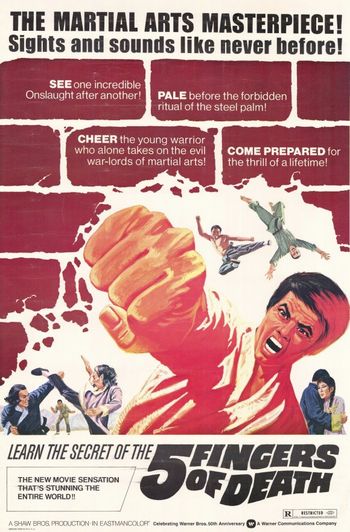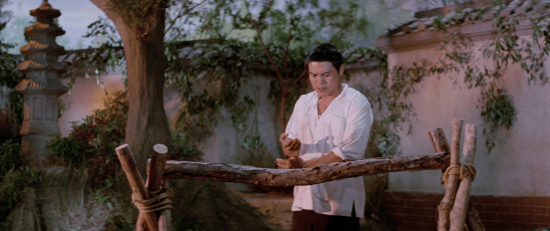Groupthink doesn't live here, critical thought does.
Welcome!
This ad-free website is dedicated to Agnès Varda and to Luis Buñuel.
Get cool rewards when you click on the button to pledge your support through .
Thanks a lot acorns!
Your kind generosity keeps the reviews coming!
 Before Bruce Lee’s “Enter the Dragon” set a new standard for the American public’s newfound obsession with martial arts movies in 1973, another, more traditional, Chinese Kung Fu movie had already set the stage for its success.
Before Bruce Lee’s “Enter the Dragon” set a new standard for the American public’s newfound obsession with martial arts movies in 1973, another, more traditional, Chinese Kung Fu movie had already set the stage for its success.
China’s legendary Shaw Brothers studio helped pave the way for Bruce Lee with a similar Warner Brothers distribution deal that placed “5 Fingers of Death” on grindhouse and drive-in screens across the country in the spring of that year.
The story contains elements from television’s “Kung Fu” series and even steals an iconic bar of unlicensed music from the “Ironside” courtroom series — which Quincy Jones composed. Listen for the “Psycho”-like horn screeches that accompany our hero’s use of the deadly Iron Fist technique that causes his fists to glow red.
Cool.
By the end of 1973, “5 Fingers of Death” was in regular double-feature rotation with “Enter the Dragon.” It was the perfect diamond-in-the-rough warm-up act.
If the film’s unforgettable title wasn’t enough to capture audience imaginations, the film itself paid off on its brutal promise of dynamic and outlandish violence. I saw the movie when I was a kid — my dad took me to see it on Christmas Eve — and the memory of watching a deadly villain rip out the eyeballs of his opponent before dropping the bloody orbs unceremoniously on the ground is forever etched in my memory. So too, obviously, is the mortal anguish that the destructive act had on its victim.
Martial arts actor Lo Lieh was already Asia’s first Kung Fu superstar after making a slew of action movies under the Shaw Brothers, dating back to 1965. In “5 Fingers” Lo plays Chi-Hao, a young Kung Fu student in love with his aging master’s daughter. A gang of Japanese thugs from an outlying martial arts school are looking to take over the region by taking out Chi-Hao’s master. Chi-Hao begins studying with another shifu in the secret technique of the Iron Fist. His training involves thrusting his hands repeatedly into hot gravel, and striking trees wrapped by a single strand of rope. Breaking tree limbs is also part of his regimen. An upcoming tournament looms.
An anti-Japanese ethos of explicit racism, no doubt informed by the then-recent occupation during World War II, runs through the storyline. Dung-Shun is the villainous leader of the Japanese mob that ambushes Chi-Hao and ties his arms around a tree before smashing his hands to bloody pulps. Chi-Hao’s disability only makes him train harder to prove his abilities in the upcoming tournament.
“5 Fingers of Death” includes a double climax that undermines its clichéd storyline. An air of magical-realism infuses Chi-Hao’s Iron Fist technique that he uses to settle the story’s final score. Included in Quentin Tarantino’s list of 12 favorite movies of all time, “5 Fingers of Death” is notable for its regular use of flying sidekicks to punctuate fight sequences that represent microcosmic battles against outside influences. They are literal fights to protect an ancient culture under constant attack.
Rated R. 98 mins.










